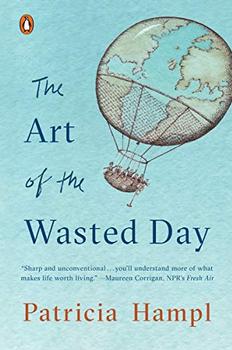Summary | Excerpt | Reviews | Beyond the Book | Read-Alikes | Genres & Themes | Author Bio

This article relates to The Art of the Wasted Day
 The word flaneur sounds like a term for a connoisseur of flannel fabric but, in fact, the Oxford dictionary defines flaneur as "A man who saunters around observing society." It is derived from the French word flâner which means "saunter, lounge."
The word flaneur sounds like a term for a connoisseur of flannel fabric but, in fact, the Oxford dictionary defines flaneur as "A man who saunters around observing society." It is derived from the French word flâner which means "saunter, lounge."
According to an article in the New Republic, Charles Baudelaire gave birth to the term in an essay called "The Painter of Modern Life", describing a person who is a "passionate spectator," open to and interested in all that's around him. Not a real person, at that point, as it came from Baudelaire's imagination. But the flaneur has become real enough through many subsequent people, real and fictional alike.
Virginia Woolf took a walk in Tavistock Square, London that inspired To the Lighthouse. She later wrote "I cannot get my sense of unity and coherency and all that makes me wish to write The Lighthouse etc. unless I am perpetually stimulated." And indeed, her Mrs. Dalloway said, "I love walking in London. Really, it's better than walking in the country."
 Sophie Calle, a French artist, began her life as a flaneur one day when, out of boredom, she began following and photographing people at random. This went on for months. Then at a gallery opening one evening, she spotted a man whom she had followed that same afternoon. Upon overhearing that he was going to Venice the next day, she went to Venice too and followed him yet again under the disguise of a blond wig, until he recognized her. All this was compiled into a book and installation called Suite Vénitienne.
Sophie Calle, a French artist, began her life as a flaneur one day when, out of boredom, she began following and photographing people at random. This went on for months. Then at a gallery opening one evening, she spotted a man whom she had followed that same afternoon. Upon overhearing that he was going to Venice the next day, she went to Venice too and followed him yet again under the disguise of a blond wig, until he recognized her. All this was compiled into a book and installation called Suite Vénitienne.
Paris appears to be the city most associated with the flaneur. Author Edmund White, who lived in Paris for 16 years, wrote a book called The Flaneur: A Stroll Through the Paradoxes of Paris, about all his wandering through its streets and avenues. In the 18th century, Louis-Sébastien Mercier, who was the first street reporter of Paris, walked around the city, noting everything he saw, from prostitutes to greengrocers, washerwomen to street vendors, servants to priests. He said about his Tableau de Paris, which spanned 12 volumes "I have run around so much while drawing my 'Tableau de Paris' that I may be said to have drawn it with my legs."
In this day and age, with technology ever more pervasive, there's crucial value in getting up and getting out for a while. Sure, the internet can be useful for seeing faraway places, but sometimes going out to the intersection at your corner and just watching the cars passing by or walking up the street in your neighborhood and noticing something you haven't seen before can give you a new perspective.
Paul Gavarni's Le Flâneur, 1842
Sophie Calle's photographs of a man in Venice
Filed under Cultural Curiosities
![]() This "beyond the book article" relates to The Art of the Wasted Day. It originally ran in April 2018 and has been updated for the
April 2019 paperback edition.
Go to magazine.
This "beyond the book article" relates to The Art of the Wasted Day. It originally ran in April 2018 and has been updated for the
April 2019 paperback edition.
Go to magazine.
Your guide toexceptional books
BookBrowse seeks out and recommends the best in contemporary fiction and nonfiction—books that not only engage and entertain but also deepen our understanding of ourselves and the world around us.